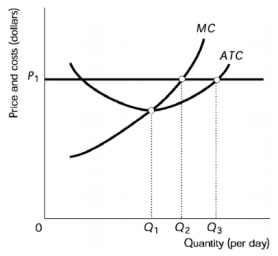To determine the profit-maximizing quantity for a firm, it is essential to understand the relationship between marginal revenue (MR) and marginal cost (MC). The profit-maximizing quantity occurs at the point where MR equals MC. This principle applies universally, indicating that firms should produce up to the point where the additional revenue from selling one more unit equals the additional cost incurred to produce that unit. It is important to note that this point can also represent a loss-minimizing quantity if the firm is not making a profit.
In a perfectly competitive market, the price (P) is constant and equal to both average revenue (AR) and marginal revenue (MR). For example, if the market price for a bushel of wheat is \$4, this price will be reflected in the firm's demand curve, which is also its MR curve. To find the profit-maximizing quantity, one must identify where the MR curve intersects the MC curve on a graph. If the intersection occurs at a quantity of 4.5 bushels, and the firm cannot produce half units, it must choose between producing 4 or 5 bushels. Producing 4 bushels would yield a profit since the revenue exceeds the cost, while producing 5 would result in a loss as costs would surpass revenues.
To calculate profit, the formula used is:
Profit = (Price - Average Total Cost) × Quantity
Here, the term (Price - Average Total Cost) represents the profit per unit. The average total cost (ATC) must be determined at the profit-maximizing quantity. If the price is greater than the ATC, the firm makes a profit. Conversely, if the ATC exceeds the price, the firm incurs a loss. If the price equals the ATC, the firm breaks even, resulting in neither profit nor loss.
In summary, the steps to analyze profit or loss are straightforward: first, identify the quantity where MR equals MC, then determine the price and ATC at that quantity. This process allows firms to make informed decisions about production levels to maximize profits or minimize losses.




